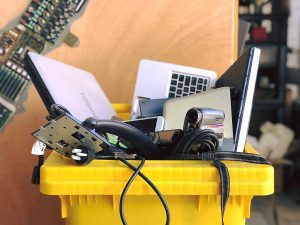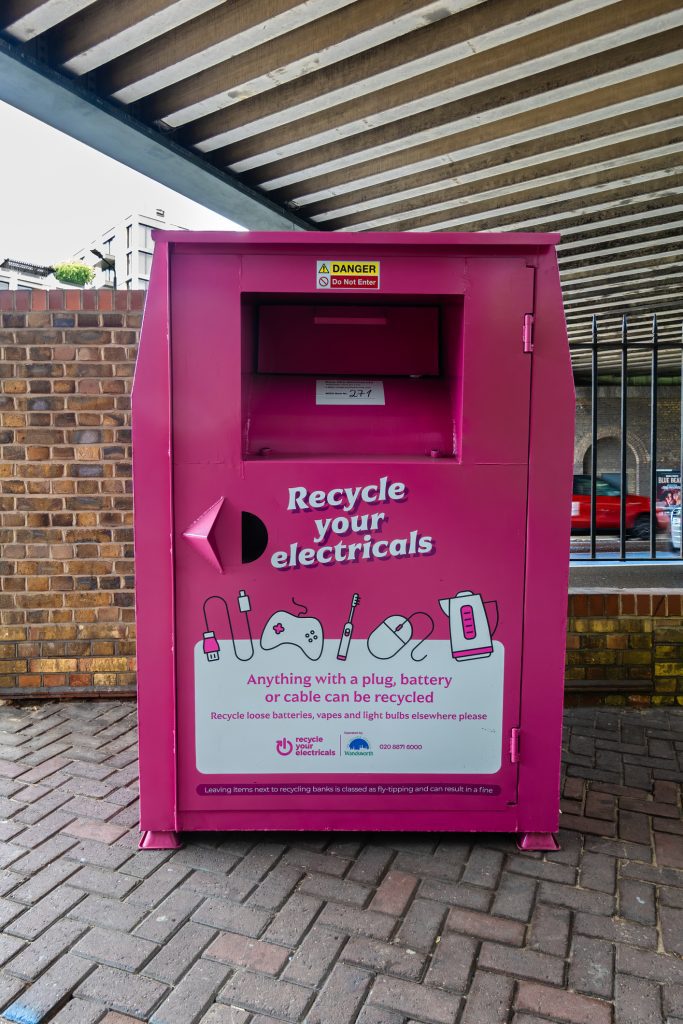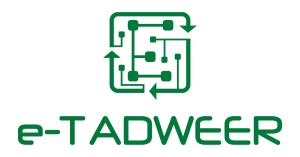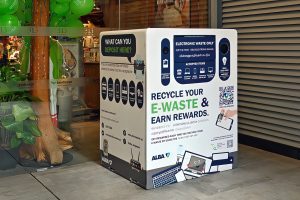Every summer Population Education is fortunate to host interns from around the U.S. These students bring their talents and passions to the PopEd program by completing a wide variety of projects. The following blog was written by one of PopEd’s 2025 summer interns.
Electronic waste, or e-waste, is one of the fastest-growing waste streams worldwide. Examples of e-waste include discarded electrical and electronic devices such as computers, smartphones, televisions, appliances, batteries, and even medical devices. Essentially, any item powered by electricity or batteries that has reached the end of its useful life is considered e-waste.

Fortunately, cities and countries around the globe are pioneering creative solutions to tackle the mounting e-waste problem. Two standout examples, Egypt’s E-Tadweer app and Cambridge’s bright pink e-waste bins, demonstrate how targeted initiatives can make a measurable difference.
The Power of Pink: Cambridge’s E-Waste Revolution
In the UK, making e-waste recycling convenient for residents has become increasingly important as the volume of discarded electronics continues to grow. To address this need, the Cambridge City Council and South Cambridgeshire District Council introduced a simple yet striking solution to e-waste recycling: bright pink bins dedicated to small electrical items. These bins are impossible to miss and are strategically placed to encourage residents to recycle items like toasters, mobile phones, and other small appliances that can’t go into regular curbside recycling.

The results have been remarkable. Since the pink bins were installed, e-waste collected for recycling has increased ninefold. From this, over 49,000 kg of small electrical appliances have been collected since the program began in 2022. Items placed in the pink bins are sorted for reuse or recycling, which diverts hazardous materials from landfills, reduces environmental harm, and recovers valuable resources like copper and lithium that can be reused in new products.
The success of Cambridge’s pink bins illustrates how visibility, convenience, and community engagement can dramatically increase e-waste recycling rates.
Incentivizing Change: Egypt’s E-Tadweer App
 Egypt faces a rapidly growing e-waste challenge, driven by population growth, increased electronics consumption, and limited public awareness around safe electronics disposal. To address this, the Egyptian Ministry of Environment launched the E-Tadweer mobile application in 2021, a digital platform that makes recycling electronics both easy and rewarding.
Egypt faces a rapidly growing e-waste challenge, driven by population growth, increased electronics consumption, and limited public awareness around safe electronics disposal. To address this, the Egyptian Ministry of Environment launched the E-Tadweer mobile application in 2021, a digital platform that makes recycling electronics both easy and rewarding.
The E-Tadweer app has been highly successful. There have been 170,000+ downloads and the app holds 84,000 active users, indicating strong public interest. The users have facilitated around 2,500 e-waste drop-offs. Overall, around 45 tons of CO₂ emissions have been saved by ensuring devices are recycled safely rather than dumped or incinerated.
Users can exchange unwanted electronics for vouchers, redeemable at participating stores for discounts on new products, creating a direct financial incentive to recycle.
The e-waste app also raises awareness through social media campaigns and community outreach, helping to shift public attitudes toward responsible e-waste disposal. By leveraging technology and incentives, E-Tadweer turns recycling into a win-win for both consumers and the environment.
Successfully Managing E-Waste
Across the globe, the need for convenient and effective e-waste solutions has never been greater. Programs like Cambridge’s pink bins and Egypt’s E-Tadweer app show that practical, user-friendly e-waste solutions can dramatically boost collection rates.
Cambridge and Egypt aren’t the only places experimenting with innovative approaches.
- Singapore enforces producer responsibility for collecting and recycling e-waste, while community initiatives help residents repair old devices.
- The UK’s Royal Mint is developing technology to extract precious metals from discarded electronics, turning e-waste into valuable resources.
 These efforts reflect a growing global trend toward more sustainable e-waste management, with increasing investment in recycling infrastructure, public education, and innovative technologies helping to boost recycling rates and reduce the environmental impact of discarded electronics.
These efforts reflect a growing global trend toward more sustainable e-waste management, with increasing investment in recycling infrastructure, public education, and innovative technologies helping to boost recycling rates and reduce the environmental impact of discarded electronics.
Why These Solutions Matter
The dangers of improper e-waste disposal are real. As our reliance on gadgets grows, so does the challenge of safely disposing of old devices. Globally, only about one-fifth of e-waste is recycled, with the rest ending up in landfills or informal dumps where toxic materials can leach into soil and water. Improper disposal and recycling of e-waste release toxic substances such as lead, mercury, cadmium, and dioxins into the soil, air, and water. These pollutants cause environmental contamination that harms ecosystems and poses serious health risks, including neurological damage, cancers, and reproductive problems.
If you’re a high school teacher, we offer a printable case study on Agbogbloshie, which was once considered the e-waste capital of the world. Or check out these ideas for teaching about e-waste.
The Path Forward
As technology continues to evolve, so must our strategies for managing its afterlife. Cities and nations that invest in creative, scalable e-waste solutions not only protect the environment but also recover valuable resources and inspire positive change. Whether through eye-catching collection bins or digital incentives, these global e-waste management examples offer a blueprint for communities everywhere to follow.
With these innovative e-waste solutions, the future of e-waste management is bright—and, in some places, pink.
Image credits: Bin with electronic waste (Patrickewastenz, CC BY-SA 4.0, via Wikimedia Commons); Pink e-waste bin (ID 317072948 © David Taljat | Dreamstime.com); E-waste recycling bin in Singapore (Recycle E-Waste Bin by chooyutshing is licensed under CC BY 2.0)




